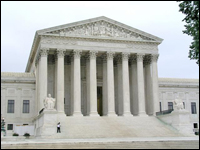
Bush speaks his mind at the second debate.
Photo: Joe Angeles/WUSTL.
President Bush‘s remarks about Supreme Court appointees during the debate last Friday left many Americans scratching their heads, what with his perplexing reference to the 1857 Dred Scott slavery case (a coded wink to pro-life factions, as it turns out) and some classic Dubya-style language mangling: “[T]he Dred Scott case … is where judges years ago said that the Constitution allowed slavery because of personal property rights. … The Constitution of the United States says we’re all — you know, it doesn’t say that. It doesn’t speak to the equality of America.”
In a more coherent moment, Bush said that were he to appoint a new justice to the Supreme Court, he would “pick somebody who would not allow their personal opinion to get in the way of the law.”
Yet that very day, a report [PDF] released by the nonprofit Environmental Law Institute suggested otherwise: It appears that quite a number of Bush’s judicial appointees may allow their personal opinions to get in the way of the law — or at least that’s how it looks to many environmental advocates.
Federal judges appointed by Democratic presidents are at least three times more likely than those appointed by Bush to rule in favor of plaintiffs who sue the federal government for violating certain environmental regulations, the report found. The study focused on cases filed under the National Environmental Policy Act, a cornerstone law signed by Richard Nixon in 1970 that requires federal agencies to evaluate the environmental impact of their policies and programs with written statements and a transparent process open to public input.
NEPA is one of the most frequently invoked tools of environmental litigators: “It’s a Swiss Army knife of environmental law,” said Jay Austin of ELI, one of the authors of the report. “It’s one of the most basic lines of legal inquiry [on the environment]. Any time the federal government is taking action that might have significant environmental implications, NEPA is invoked.”
ELI chose to focus on this statute because of the sheer number of NEPA cases that have been brought against federal agencies during the past four years. “We had a critical mass of cases to examine,” said Austin, explaining that the larger the number of cases there are to consider, the more statistically significant the findings will be. The report examined 325 judicial rulings handed down between January 2001 — the month Bush assumed office — and June 2004.
“By no means did we expect to see the degree of polarization that party affiliation appears to have on judicial rulings,” added Austin. “We were more than a little surprised.”
ELI’s findings may not come as a surprise, however, to those who have been closely following Bush’s hotly contested judicial nominations. “George W. Bush has tried to appoint some of the most conservative judicial nominees in history,” said Adam Shah of the Alliance for Justice, a D.C.-based public-interest organization that monitors and investigates judicial nominations. “Ten of the most extreme have been filibustered, but there are plenty of controversial judges that have made their way onto the federal bench.”
The president’s judicial nominations aren’t the only issue in play here, though. The report reveals a pattern of discrepancy between Republican and Democratic rulings that goes beyond Bush’s appointees, who constitute 23 percent of active federal judges.

How hallowed are the halls of justice?
Photo: Kevin Connors.
Of the 849 total active federal judges, 201 have been appointed by the current president, and 262 were appointed by former Republican presidents going back to Nixon. In total, 55 percent are Republican appointees. The remaining 45 percent were appointed by Democratic presidents stretching back to Lyndon Johnson. The report shows that federal district judges appointed by a Democratic president ruled in support of pro-environment NEPA cases 60 percent of the time, while GOP-appointed judges ruled in support 28 percent of the time. (The Bush appointees, by comparison, only ruled in favor 17 percent of the time.)
“We’ve always known there are ideological differences between Democratic- and Republican-appointed judges, and that the Democrats are more likely to protect the environment,” said Shah. “But what’s particularly striking about these results is that the president’s judges have been even more extreme than those appointed by Ronald Reagan and George H.W. Bush.”
The study showed that this pattern held true at the appellate level as well: Three-judge circuit court panels with two or more Democratic appointees ruled in favor of environmental plaintiffs 58 percent of the time, whereas only 10 percent of cases were decided in favor of environmental plaintiffs when the panels were Republican-dominated.
Austin added a note of caution about the implications of the study: “Keep in mind that this report is focusing on NEPA alone, and this statute has a lot of broad-strokes language that leaves a little more room for interpretation than other environmental statutes. You can’t necessarily extrapolate that rulings made on NEPA grounds represent the larger picture of judicial rulings on the environment.” With this in mind, the ELI team is planning to conduct a similar study of rulings on statutes with more rigorous language, such as the Clean Water Act and Clean Air Act.
Tom Fitton, president of Judicial Watch, a conservative D.C.-based ethics-watchdog group, dismissed the notion that the ELI report reveals bias. “It ought not to be surprising that conservatives would take a less expansive view on the regulatory powers of the government … and be more suspicious of the inordinate emphasis on making sure that every environmental rule and regulation is followed,” Fitton told Muckraker, arguing that conservative judges would likely take a particularly narrow view on a law like NEPA, which requires extensive written reviews and so-called bureaucratic red tape.
Fitton said the report’s findings “say to me that Republican appointees may be applying stricter standards to the way they interpret NEPA — they would be sticklers for following the letter of the law when it comes to enforcing the statute.” Democratic appointees may be applying a looser standard, “interpreting it more expansively,” he said. “It doesn’t imply a bias — they’re different philosophies.”
Such assertions gall Patti Goldman, managing attorney at Earthjustice, who argues that congressional statutes such as NEPA are supposed to be applied by judges, not modified according to markedly different judicial philosophies. “This report shows a pronounced and striking difference in the interpretation of the law, not just a subtle difference in philosophies that guide its application,” she said. “Once statutes are interpreted to this extent, it indicates that neutral judges are taking an activist stance with the law. And once you can predict the outcome of cases before they’re even brought to court based on whether it’s a Republican or Democratic judge, it indicates a deep flaw in the fabric of our democracy. It makes you realize that it really, really matters who appoints the judges.”
A particularly poignant point now, considering that three to four Supreme Court justices are expected to retire by the end of the decade, and it will be up to our next president to begin replacing them.

